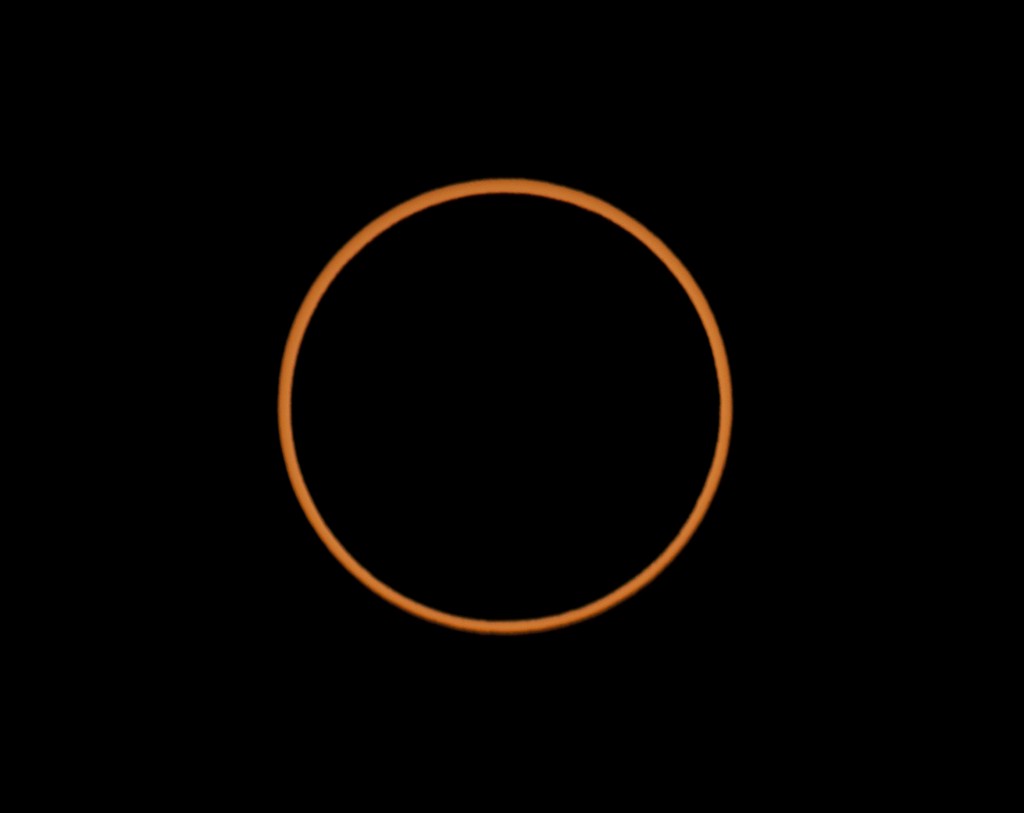Annular versus Total Solar Eclipse

I am often asked to describe the difference between a Total and an Annular Solar Eclipse.
The key difference is that the Moon is further away from the Earth, with the disc of the Moon no longer fully covering the Sun. Instead, a ‘ring of fire’ remains. Even though the light is greatly reduced, it is still not possible to safely view with the naked eye and solar filters must be used at all times, even during annularity. The most exciting and thrilling features of totality will not be seen or experienced.
An Annular eclipse is pretty special, but if you are used to seeing a Total Eclipse then an Annular feels like a great buildup and then the peak just doesn’t happen. This is the reason why Geordie jokes that he “won’t get out of bed for anything less than a Total’ these days.
What does it feel like to experience a partial eclipse, an Annular, and a Total? To me, it comes down to the degree of immersion and intensity. On a scale of 0 to 10 of immersion and intensity, a partial eclipse I would rate about a 4—it is interesting, it makes you think about the Universe in a three dimensional way, you become aware of the inevitability of the Universal clock. An Annular Eclipse I would rate about an 8—there are added experiences such as the gradual dimming of light, animal reactions, the approaching darkness, and seeing the Ring through solar filters. It is pretty awesome. On the same scale of immersion and intensity, I would rate a Total Solar Eclipse as 100. This is because once you experience the Total Eclipse you realize that it is on a completely different scale altogether, and just cannot be compared. It completely blows you away.
Many analogies have been used to describe the partial versus Annular versus Total Eclipse experience. Here is an example that many can relate to, using a musical concert:
You have just received word that your favorite band in the world will be performing – and they are coming to your town! You queue up to purchase your tickets in advance, feeling very excited when you have them in your hand. Finally the day comes and you make your way to the venue. You find a spot that is close to the front, and it just so happens to give you a great line of sight of everything. The support band plays for an hour and you get caught up in the excitement, waving your arms in the air and dancing away as one with the crowd. The support band ends their set, and the crowd starts cheering excitedly, building up a crescendo of noise and screams until the moment arrives – your band comes on stage! You see them! You are beside yourself with excitement. For the next two hours, the band plays all of your favorite songs, and you feel like you are in your own little world, just you and the band, as you are part of this magical moment. You go home that evening feeling so incredibly lucky, and content with your life.
Here’s the comparison – seeing a partial eclipse is like getting your tickets to the concert. An Annular Eclipse would be like going home just when the support band ends their set—right when things just start to get exciting. The Total eclipse is experiencing the whole thing.

March 13, 2015
[…] 99% totality is nothing like the same as Totality … well worth seeing a total eclipse once in a lifetime This quote sums up my own feeling: "On a scale of 0 to 10 of immersion and intensity, a partial eclipse I would rate about a 4 – it is interesting, it makes you think about the Universe in a three dimensional way, it makes you feel insignificant, you become aware of the inevitability of the Universal clock. An Annular Eclipse I would rate about a 9 – there are added experiences such as the gradual dimming of light, animal reactions, the approaching darkness, and seeing the Ring. It is pretty awesome. On the same scale, I would rate a Total Solar Eclipse as – 100. This is because once you experience the Total Eclipse you realize that it is on a completely different scale altogether, and just cannot be compared. It completely blows you away." Annular versus Total Solar Eclipse […]
July 17, 2015
Totality during such an eclipse can only be seen from a very small area on Earth. This area is usually about 100 miles (160 kms) wide and 10,000 miles (16,100 kms) long.
January 23, 2016
[…] takes place in September 2016. An annular eclipse is not as dramatic as a total eclipse (see my article here for the difference), but it is still an amazing sight to see the ‘ring of fire’ as the Moon […]
September 11, 2022
I’ve seen two total Solar eclipses. I am planning the third one in Texas April 8, 2024.
I saw the first in 1979 in my own backyard. The second in 2017 in Idaho.
Hopefully will have clear skies again for next one.